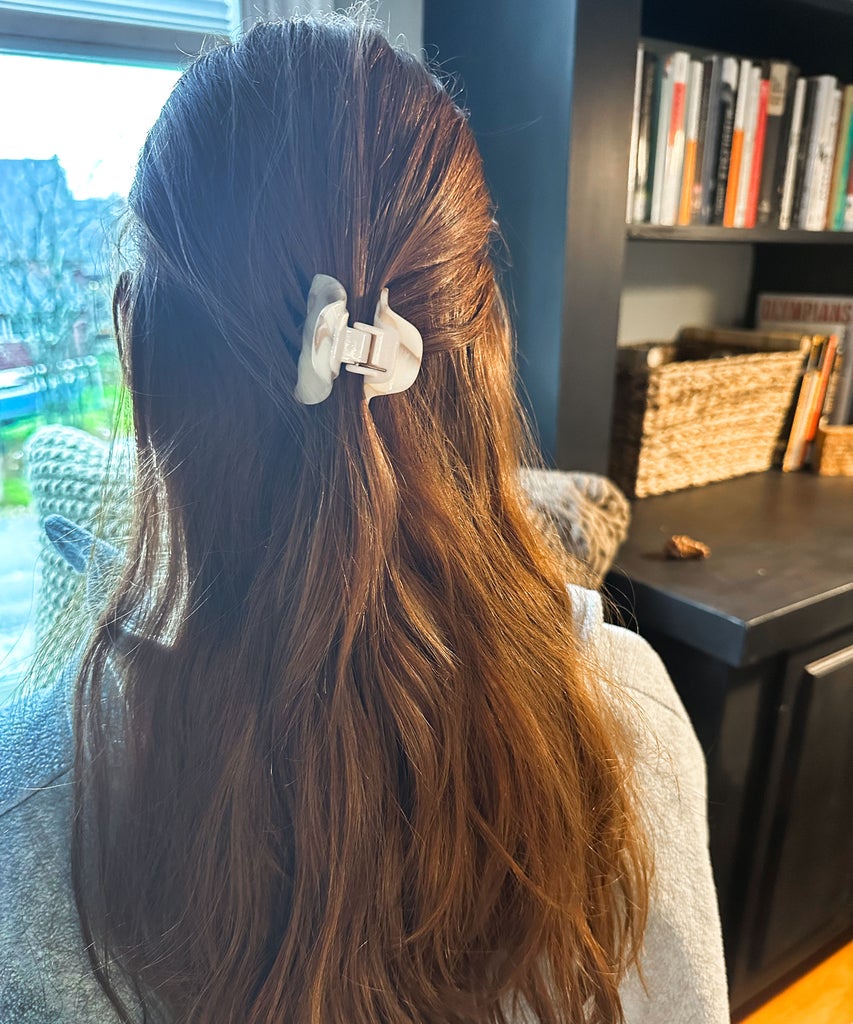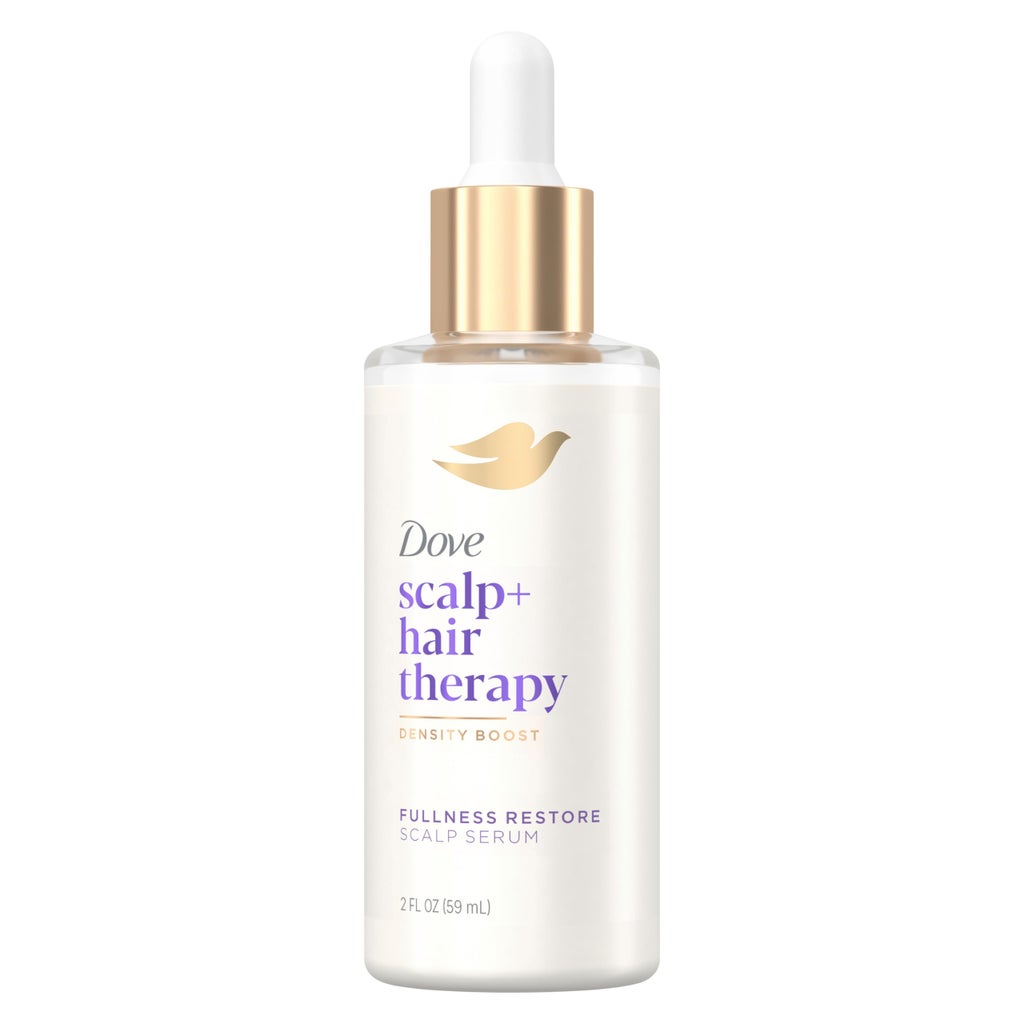
The best thing I’ve done for my hair in recent months was not one big, sweeping change but instead, smaller, precision edits that I made to my hair routine. I’ve never committed to specific “scalp care” beyond shampooing my hair in the shower three times a week — and I’ve never been all that precious with what I’m using, either. But this winter, as I started to feel the familiar itch and heat down my center part, and saw some dry flakes around my hairline when I looked in my magnifying mirror, I thought it a good time to focus on scalp TLC.
I had the pleasure of meeting with trichologist and hair-Tok sensation, Abbey Yung, to get some sustainable scalp advice that I’d want to, and be able to easily, fit into my hair routine. Personally, I knew I could never commit to a pre-shampoo or a hair oiling routine, even if they work well for others. From how to effectively apply shampoo (there’s a emulsifying step you might be missing) to how to keep your hair in its “anchorage” phase to prevent hair loss, Yung spills her best scalp-care tips, and introduced me to a $12 serum that has effectively cured my chronic winter dry scalp.
What causes dry scalp?
“When we have cold, dry weather, that generalized dryness is much more likely,” explains Yung. Each scalp case is individual, but Yung says that concerns are on the rise across the board. “I have definitely noticed an increase in questions about scalp health over the past couple of years,” explains Yung. “I feel like it’s in direct response to all of these more ‘natural,’ ‘extra gentle’ shampoos. While those can be nice every now and then, the reality is that a lot of those products are just not properly cleansing the scalp. As a result, people are ending up with these conditions that are directly related to not properly cleansing. Seborrheic dermatitis is directly related to a buildup of oiliness on the scalp and it gives people those really common concerns — itching, dandruff, flakes, scaling, sometimes even broken skin.”
Of course, mild symptoms of dry scalp are not always linked to a condition like seborrheic dermatitis — mine isn’t — but if you’re concerned, it’s helpful to see a doctor or trichologist for a personalized examination.
How do I get rid of dry scalp?
This is not a general prescription, but it is what worked for me. First of all, I started washing my hair more often. “A lot of people have heard that if you wash your scalp too often then it will strip your scalp and you’ll end up producing more oil — that’s not true at all,” Yung explains. “Our oil production is dictated by internal factors like hormones, age, genetics, environmental factors, and your diet. There are a lot of things that go into it, but how often you shampoo your scalp is not one of those things.”
As for what shampoo I use, Yung recommends something cleansing — not stripping and not extra soft. “You don’t want to be using a shampoo that’s so harsh that your scalp is feeling tight and itchy after using it,” offers Yung. “But the reality is that there aren’t a ton of shampoos that exist like that today. It used to be common when haircare wasn’t as advanced. I don’t think it’s as much of a problem as we’re led to believe it does. It still happens but it’s less of a concern than people might think who are trying to wash their scalp less often for that reason.”
Yung herself has been using the new Scalp + Hair Therapy collection from Dove. “I’m really excited about this launch from Dove because the shampoos are great at effectively cleansing,” she explains. There’s a scalp scrub, which I’ve been using on days when my hair is extra dirty, or when I’ve been wearing a slicked-back bun. “Some people have a lot of flakiness — not from dryness — but from hair gel that they’re using,” offers Yung. “In that case, I recommend the Dove Scalp Exfoliant to get rid of all of that before shampooing to make sure you’re really getting a clean scalp.”
If I’m feeling like I don’t need a scrub, I’ll just use a regular shampoo. Yung recommends the Dove Clarifying Shampoo, which is for anyone but ideal for those with thin or fine hair, or the Dove Hydrating Shampoo, designed for thicker, coarser hair types that might need more hydration. I use both.
The key, though, is in emulsifying your shampoo. Yung’s tip — which has garnered viral status on TikTok — involves rubbing your shampoo in between your hands before rubbing it into your scalp.
@abbeyyung This makes the HUGEST difference! #shampoohacks #shampoohair #hairwash #hairwashday #learnhow ♬ STAY – The Kid LAROI & Justin Bieber
“Emulsifying the shampoo in between my hands allows for it to spread more easily on the scalp,” explains Yung of why this works. It’s not about making the shampoo more sudsy. “The sudsiness has nothing to do with how effectively shampoo can clean your scalp, but what I think makes the biggest difference is emulsifying it to make it easier to spread so you’re not missing any areas,” say Yung. “People sometimes forget how much coverage the scalp covers, it’s not just the top part. I like sectioning my hair and flipping my hair over to get all those areas that are prone to getting an accumulation of oil and causing itch.”
What’s the best dry scalp treatment?
The shampoo refresh was helpful and my hair and scalp have been noticeably less dry and also less oily since I started using a scalp scrub as needed and emulsifying my shampoo. However, the biggest game-changer game has been the scalp serum.
Yung recommended I try the The Dove Scalp+ Hair Therapy Scalp Serum. It’s not a hair oil — so, it’s not comparable to say, the viral rosemary oil. Instead, it’s a water-based formula that looks, feels, and functions like a skincare serum you’d use on your face. “It really is a skincare formula,” offers Dove’s consultant dermatologist Mona Gohara, MD. Not only does the water-based formula make it absorb into the scalp instantly, its key ingredients — glycerin, niacinamide, and zinc — are hugely beneficial for the scalp, especially a dry scalp, like mine.
Dove Scalp+ Hair Therapy Scalp Serum, $12.99

Now, turn a few of your skincare products around, look at the label, and you’ll probably find glycerin at the top — it’s a commonplace hydrator in a lot of beauty products. You might find it on your shampoo bottle as well, but it will likely fall lower on the list. However, this Dove Scalp Serum has a higher, skincare-grade concentration of glycerin, to hydrate the skin of the scalp. Then niacinamide regulates sebum production on the scalp. “A lot of people think about niacinamide in the context of oily skin, but it’s helping with all forms of regulation, so that includes people who aren’t producing enough [oil] and have drier skin or scalp,” Yung explains.
More than hydrating the scalp and regulating sebum production, this Dove serum helps extend your hair-growth cycle, which may result in the feeling that you have more hair, or more hair density. But this is not hair growth serum, let’s make that clear. “What it’s helping to do is keep your hair follicle nourished so that your hair can stay rooted in the scalp for as long as possible,” explains Yung. “There’s different terminology used to describe that. But ‘anchorage’ can be helpful to envision, it’s like your hair being anchored in the follicle. Maintaining a healthy scalp can ensure that the hair stays anchored in the follicle for as long as possible, before it’s ready to shed.”
It’s an important distinction. You want to be wary if you see a hair-growth claim in an OTC scalp serum or oil. “I see a lot of brands trying to sneakily suggest that something is going to ‘promote hair growth,'” says Yung. “It’s not legal and it’s misleading marketing. Unless an intensive clinical trial was conducted with proof of these results, it’s not fair to suggest it to consumers and let them get their hopes up, especially about something as emotional as hair loss.”
Here’s how I use it: After the shower, I towel-dry my hair with my Volo Hero Microfiber Hair Towel (it absorbs the water immediately) and apply the Dove Scalp+ Hair Therapy Serum to my hairline and down my part. I massage the serum in with my fingers, and it sinks in right away. Zero mess. At this point, I can leave my hair to air dry or use a blow-dry brush when it’s 80% dry. Yung offers another helpful tip on heat styling: “Waiting until the hair is almost dry will help so your hair’s not as fragile.” As we know, brushing wet hair can cause breakage.
The takeaway
It’s been roughly three weeks of this simple routine and my scalp is not dry — no flakes or redness or itch — which is unheard of in the middle of January. I also have noticed my very-short and fine baby hairs around my hairline are falling softer and longer, thanks to the serum I’ve been applying to my hairline. For a scalp-care product that’s just as easy to apply as a leave-in conditioner, backed by a trichologist, with marketing claims I can understand, I can’t recommend this enough. It’s $12 and 100% worth it.
At Refinery29, we’re here to help you navigate this overwhelming world of stuff. All of our market picks are independently selected and curated by the editorial team. If you buy something we link to on our site, Refinery29 may earn commission.
Like what you see? How about some more R29 goodness, right here?
5 Ways To Build A "Compassionate Skincare" Routine
I Got The Kitty Cut After Years Of The Same Style
As A Hair Doctor, I Avoid These 6 Habits In Winter
from Refinery29 https://ift.tt/RhNlTfa
via IFTTT
